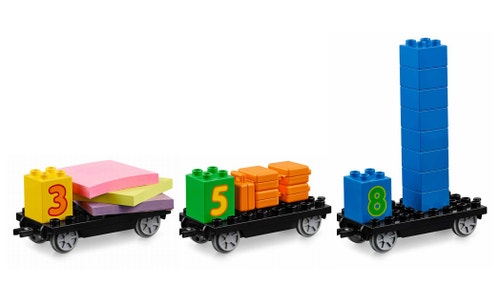Load the train
The objective of this lesson is to practice matching numbers to quantities and practice comparing quantities

Connect
Talk to the children about freight trains:
- Freight trains haul objects, materials, and all sorts of things!
- Freight is a general word we use to describe these things.Tell the children that some freight must be loaded onto the train and it’s very important that the correct amount is loaded. Too much freight and the train will be too heavy!
Construct
- Tell the children that they are going to help load the train.
- Model picking up a number brick, placing it on a train car, and finding the corresponding number of bricks in the same color.
- Load the bricks onto the train. You can even use the crane to help you! Point out that the number tells you how many bricks must be loaded onto the train.
- Encourage the children to try it on their own by picking a number, placing it on a train car, and finding the matching bricks.
Contemplate
Encourage a discussion about making sure the train has the correct amount of freight.
Consider asking questions like:
- How many bricks did we need to load onto the train?
- How did we check to make sure we loaded the correct amount?
- Why is it important to make sure that the train is carrying the correct amount offreight?
Continue
- Tell the children that freight trains can deliver all sorts of items, then ask them to collect “freight” (e.g., pens, crayons, notepads, erasers) from around the classroom and load it onto their train cars.
- Have them find the number brick that corresponds to the number of items they have loaded onto their train car.
- Once the children have loaded their train cars, facilitate a discussion about more and less by picking two train cars and asking the children which one has more and which has fewer.
- For a greater challenge, ask the children to help you place the train cars in order from least to most freight being carried.
Did you notice?
Observing the following skills can help you monitor whether the children are
developing the necessary competencies in math.
- Using mathematical terms, such as positional language, number names, etc.
- Counting using number names, and beginning to recognize the number of objects in a set
Unterstützung für Lehrkräfte
Children will:
- Practice matching numbers to quantities
- Practice comparing quantities
For up to 6 children
Math Train set (45008)
Inspiration photo 1
Inspiration photo 2
Small objects (e.g., pens, crayons, notepads, erasers)
The Mathematics guidelines from the National Association for the Education of Young Children (NAEYC) and HeadStart have been used to develop the Math Train lessons. Please refer to the learning grid for an overview of the learning values referenced throughout this Teacher Guide.
The learning goals listed at the end of each lesson can be used to determine whether or not each child is developing the relevant early math skills. These bullet points target specific skills or pieces of information that are practiced or presented during each lesson.




